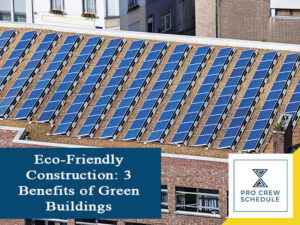One of the most pressing and demanding issues in our world today is the threat of climate change and global warming, and it affects everyone. We can see it in the daily newspapers, television, and social media platforms, but only a few take action and actually solve the problem at hand. Climate change is an urgent matter that needs to be tackled upfront, especially in the construction scene, contributing significantly to the environmental issue. According to the Global Status Report for Buildings and Construction in 2019, the building and construction segment contributed 36% of the total energy consumption and 39% of energy and processed carbon dioxide emissions in 2018, 11% of which are from the fabrication of building materials.
The architects, engineers, and designers – the design and build industries – know this. Climate change is now influencing how the people in the construction trade think about the buildings they design and build. We need sustainable and effective solutions and technologies to combat the construction industry’s problem, and we need it now.
There are various ways we can mitigate this environmental dilemma, and one of the most innovative and effective solutions that we can adapt is the introduction of green construction in our buildings, and that is what we’re going to discuss today.
What is green building?
The overall concept of green construction and sustainable building design is nothing new but has never been more crucial than the current times.
Green building is an integrable process that highlights the relationship of the built surroundings and natural surroundings and finds innovative ways to provide solutions to the negative impacts of construction development on our environment in the long run and future generations. Their construction focuses on using resource-efficient tools or materials and energy-conserving processes that are “friendly” for the environment and its inhabitants’ well-being.
First, lets’ look at the factors that make a building “green:”
What are the factors of a ‘green’ building?
– Economical use of water, energy, and other natural resources
– Maximizes the use of sustainable and renewable energy
– Introduces the use of re-use and recycle practices
– Involves materials that are healthy and ethical to the environment
– Mindful of the environmental impacts from the design to the execution phase
– Accounts the overall well-being of its builders and occupants
– Provides adaptable system and flexible to the ever-changing environment
Any structure can be classified as a green building, whether it’s a low-rise residential house or a high-rise commercial skyscraper, as long as it includes the key factors listed above. However, it is imperative to consider those different countries with various qualities such as different climate settings, unique cultures and traditions, and extensive environmental priorities that affect their perspectives to a green building.
Three Benefits of Green Buildings
1. Less economic burden
The most significant and most substantive reason why transitioning to the “green” movement is vital is its impact on our environment in the present, more so in the future generations. The climate change problem is real and urgent, and everyone has a responsibility to help combat it. In the construction spectrum, we can do this by looking at the resources we use in our daily operations and managing construction.
One of the top priorities in choosing a green building material is by looking at its contribution to enhancing biodiversity and protecting the natural balance in our ecosystem. It must possess as minimal ecological burden as possible, if not none, and helps lessen the pace of global warming on our planet. A better option would be the usage of low impact materials and promoting recycling operations on site. We can also reduce the waste stream we collect throughout the project’s execution by repurposing materials and re-using secondary industrial debris we accumulate. A decrease in waste streams also cuts down the excess materials we send to landfills and benefits our environment in many ways. Green buildings also use water-efficient appliances and fixtures that can be used even in the project’s post-construction phase when it comes to water conservation.
Eco-friendly materials are the current trend in the building materials market. 2020 has seen a boost in the number of project managers and builders incorporating more sustainable approaches by the use of popular alternative materials such as the following:
– Grasscrete
– Bamboo
– Recycled plastics
– Strawbale
– Mycelium
– Ferrock
– Hempcrete
– Ashcrete
-Timbercrete
– Wood
– Rammed earth
2. Cost-effective, in the long run
Back when the concept of green buildings was first introduced in the market, some dismissed it because of the financial misconception. This belief has long been denied, thanks to the wide-range advantages they have over traditional buildings in different aspects.
The initial cost of the green building can indeed be higher than the conventional construction. However, according to some studies, any additional charges it usually entails in the design and execution phase are little to no difference in the total cost. It is also worth noting that the houses built using green methods incur higher rents and property rates once built.
Green building also uses features that assure efficient use of water, energy, and more eco-friendly materials. As a result, constructing green minimizes the operation and maintenance costs, making green buildings cheaper in the long run and the most cost-effective option for users. Some of the eco-friendly appliances you can use in your buildings are the solar panels, wool insulation, solar tiles, and bio-composites.
Reduction of the operating cost is the second most significant reason why green construction is the best choice, which is also decided early-on by the general contracting team of any project.
3. Improves the overall quality of living
Green building is not only helpful to the environment but your health too.
There’s nothing more satisfying than the feeling of having a clean home, not only in its interior but in its entirety. It is fulfilling to know that a significant portion of your asset, such as your house, produces good benefits to the environment, our first and original home.
A green building can improve health by considering IEQ or the Indoor Environmental Quality of our buildings. If anything that the COVID-19 pandemic showed the world in the duration of the global lockdown and quarantine, it is important to make our homes as pleasant and safe as possible. This is why the green construction encourages the use of low-emitting materials in construction, such as non-VOC paints for the surfaces, formaldehyde-free for the furnishings, and moisture-protected products for the paneling.
During the construction process, eco-friendly techniques also greatly help the employees and the workers on site. They won’t be exposed to different toxic gases and ingredients, and other components usually present in most construction materials. It will also inspire them to envision other ways to integrate sustainable practices in their daily lives once the employees and workers are exposed to the advantages of green living.
Green workplaces also help employees and workers improve their physical health and their psychological health as well. An eco-friendly environment contributes to productivity, workplace satisfaction, sense of community, work output, and stress. Communication in construction is also essential to ensure that there aren’t misunderstandings and the project goes as smoothly as possible. Therefore, sustainable buildings are vital in a company’s business function and overall operation to produce the most productive and efficient team an enterprise can have.
Popular Green Buildings Around the World
Here are some of the most famous green buildings around the world that adopted this technology that can inspire you to pursue it as well:
– Shanghai Tower in Shanghai, China
Only second to Burj Khalifa as the tallest building globally, Shanghai Tower prides itself on its smart controls that regulate all aspects, from lightning to ventilation, which also helps lessen the energy bills and expenses.
– Bullitt Center in Seattle, USA
Appointed as the greenest and most sustainable building globally in 2013, Bullitt Center was conceptualized to have an ideal lifespan of 250 years using photovoltaic panels to accumulate its electricity.
– ACROS Fukuoka Foundation Building in Fukuoka, Japan
ACROS Building in Japan features a systematized design in water management. It is also considered the perfect embodiment of eco-architecture – a concept where architectural design and native greenery meet.
Conclusion
Before we get the rewards of employing green construction in our projects, a commitment to using them must be decided from the project planning, even before gathering the contracts in construction. The consultants, architects, and engineers should be well-acquainted first with the green building certifications and methods they are attempting to employ.
The bottom line is, the Green Building is the future of the construction industry, as we have seen from the three benefits discussed above and from the examples of the world-class structures that adapted this technology upfront. It can help lessen the global environmental burdens, save money, and improve the quality of life of the ones building it, even those occupying it.
In a constantly changing and evolving world, we cannot stick to the conventional and traditional ways we are accustomed to, especially in the fast-paced build-and-design industry that we work in. Green building is innovative, ethical, and a worthwhile investment for the future, and there is no better time to take action but now.
So let’s make the world a better place, one green building at a time.







